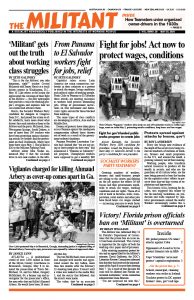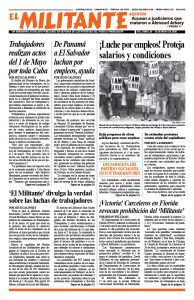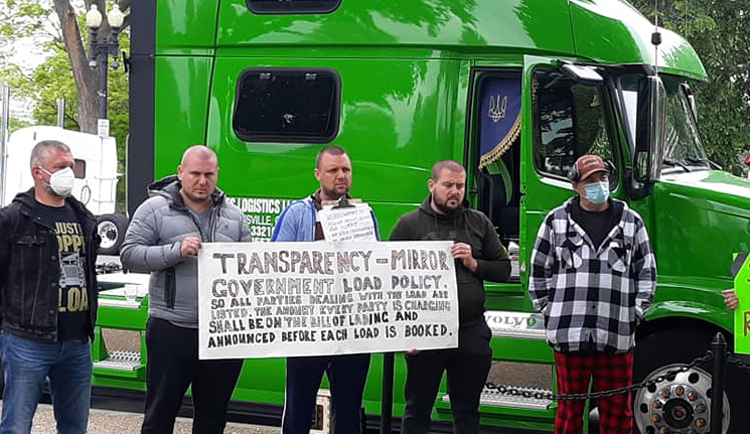Beginning May 1, hundreds of truckers in their rigs converged on Washington, D.C., Los Angeles and Chicago to fight to defend their livelihoods. As part of discussions about how to organize owner-operators alongside fleet drivers to fight the bosses and brokers, the Militant is running excerpts from “How the Teamsters Union Organized Independent Truckers in the 1930s” by Farrell Dobbs. It is an appendix to Teamster Politics, part of his four-volume series on the history of the Teamsters and their class-struggle leadership in Minneapolis. Dobbs emerged from the ranks to become a leader of the 1934 Teamsters strikes and of the Communist League of America, forerunner of the Socialist Workers Party. He became the central organizer of the 11-state over-the-road campaign that brought tens of thousands of truckers into the union. Copyright © 1975 by Pathfinder Press. Reprinted by permission.
During the depression of the 1930s individually owned trucks appeared in the transportation industry in ever-increasing numbers. A major factor in this development was an intensive sales campaign by the auto corporations. Their caper was to induce the unemployed to buy themselves a job by buying a truck. Workers who could scrape up the down payment were allowed to meet the balance of the purchase price on a long-term installment basis. Incentive for such purchases was given by the federal government, which used individually owned trucks on its “make-work” projects for the unemployed of that period. State, county, and city engineering departments followed suit, especially in connection with road work.
Comparable trends developed within private industry. Firms having their own fleets of trucks often kept a surplus of rigs on hand by hiring independent owner-operators, who usually found themselves payless — despite the time put in — when they were not actually hauling something. Fluctuations in business volume were thus compensated for at the expense of the owner-operators and to the profit of the fleet owners. Broker setups appeared in the form of companies that relied entirely on individual truck owners to move goods. In such cases virtually the entire overhead cost of trucking operations was shoved on to the owner-operators, thereby impairing their capacity to earn a living. …
Immediate profit-taking along these lines was not the only object the capitalists had in mind. Advantage was sought from ambitions that developed among independent owner-operators to expand their holdings and go into business for themselves. Illusions were fostered that such prospects were open to all individual owners, so as to trick them into identifying themselves with the problems of management. To the extent that the scheme worked, divisions were sown between owner-operators and the drivers of company fleets. Unionization of the industry was thereby impeded; the laws of the open-shop jungle could better prevail; and the trucking bosses were able to wax fatter in all respects. …
In shaping our overall class-struggle policy, close attention to the independent owner-operator question was included. We began by taking full account of the realities of the existing situation. Drivers owning their own trucks had become a factor of major dimensions within the industry. To consolidate the union power, they had to be brought into an alliance with the fleet drivers. Before that could be done, however, a course had to be developed that would serve the owner-operators’ interests.
Careful examination of all the factors involved convinced us that those owning one truck, who did their own driving, should be approached by the union as fellow workers. Proceeding accordingly, we set out to organize as many of these individuals as possible. They were then extended the democratic right to shape the demands that were made upon their employers, the leasing companies. On that basis the union as a whole followed through by backing them in struggles to improve their take-home pay.
The validity of that policy was confirmed by its results. In the major struggles of that period against the trucking employers generally, the union’s owner-operator members served loyally. They volunteered their trucks to transport pickets and shared in the picketing. A significant number of our casualties in battles with the cops were from among this category of workers. After the union had been consolidated, they continued to play a constructive role. …
Our course had checkmated the divisive schemes of the bosses. In Minneapolis the truck drivers and allied workers had emerged as a power, and the union was able to march forward in advancing the interests of all its members. …
A man who owns the truck which he drives is merely an employee who is required to furnish his own tools as a condition of employment. He has a full legal right to be represented by a labor organization. …
We approached the equipment as expensive tools the individual owner-operators had been required to provide in order to get jobs as drivers. This served our objective, which was to make the leasing companies pay for the use of those tools, as though they were the owners. That would reduce their advantage down to having the owner-drivers buy the equipment initially, and there wouldn’t be much percentage for the operating companies in such an arrangement. To the extent that we could succeed in that course, the trend toward an increase in the use of owner-operated rigs could be reversed; and a healthier situation could be established, with trucking firms again using their own fleets, operated by drivers paid on a regular wage basis.
In striving toward that goal we were aided by gains registered in securing higher wages and better conditions for fleet drivers. Those accomplishments were noted by the owner-operators, many of whom began to realize that they, too, would be better off as fleet drivers.


